Riding the Texas Eagle
Detour
November 2013
by Dave Ingles
| In groups of separated dates in late October and November 2013, owing to Union Pacific trackwork on the main line between Longview and Dallas, Texas, the northbound Texas Eagle, train 22, was detoured on a direct route between Taylor and Longview, Texas. The southbound train did not detour. The route "cuts the triangle" and so was 100 miles or so shorter than the normal route, so the train would usually arrive early into Longview and wait for departure time and the buses covering the normal stops, which included Temple, McGregor (Waco), Cleburne, Fort Worth, Dallas, and Mineola, all in Texas. Most of the known "rare mileage collectors" needed at least a part of the detour, as Missouri Pacific had not run passenger service on it since the late 1960s, and UP steam excursions had covered only parts of it; a few Amtrak detours had done similar over the years.
Chuck Weinstock, from Pittsburgh, one of my usual travel companions, suggested riding it north on Sat., November 9, which was agreeable to me since late October was full of conflicts for me. The detour would last only a few more days after we rode. We wound up in a group with several friends and acquaintances. This was only the second major trip in recent years, both of them train-riding trips, on which I left my slide camera at home. I needed the entire detour, giving me 226 new miles. I left Milwaukee Thurs. Nov. 7 on Hiawatha 334 and connected to Eagle 21 in Chicago, on which i had a lower level roomette in the sleeper, 2nd car from the front. I would have the same train consist, and on-board crew, for the entire round trip, of course. Seeking as long and comfortable night as possible, I used Amtrak Reward Points (i.e., free) to a round trip ticket to Austin. I also used Hilton Honors points for my Austin overnight in a Hampton Inn, so essentially my only trip expenses were tips, beverages, and one Austin taxi ride ... oh, and I used up 11-month-old tickets for my Hiawatha round trip, before they expired in late November. The expenses were in the true "frugal" (i.e., cheap) Milwaukee tradition. I traveled solo southbound as far as Fort Worth, where friend and retired Amtrak station agent John Arbuckle joined me. He lives in Kansas, and drove to Norman, Okla., where he can park his car for free, and rode the Heartland Flyer to Fort Worth. |
| My first pictures were at St. Louis during the layover; we arrived 26 minutes late at 7:47 and left at 8:12, 12 minutes late. I'd eaten dinner out of Springfield right at dusk; both my car attendant, Ernesto Rodriguez, and the dining-car servers, who were lead attendant Tony Clementi and a woman from Chicago who is a Boston Red Sox fan but is married to a St. Louis Cardinals fan (I didn't catch her name; she was not at my table for any meal) were excellent. |
| Next morning, after sitting for a long time at Marshall, from before pulling into the depot from nearby at 7:34 and departing 1 minute late at 7:51, we arrived at Longview at 8:18. I detrained for some fresh air and a few photos. Normally I do not bore viewers with entire train consists, but the Eagle is short and we had the same consist for the whole Chicago round trip, so here it is: Engine 176, dorm sleeper 39023, sleeper 32077 Dist. of Columbia, diner-lite 37010, Sightseer lounge 33024, coach-bag 31010, coach 34094, and coach 34116. At Fort Worth we picked up two PV's on the back, from Milwaukee's own Charter Mfg. Co., but I never got a photo of them; they went to San Antonio. They are painted NYC two-tone gray but are smooth-side cars (ex-UP, I think). |
| At Dallas, the train was perfectly backlit, so I didn't bother with a front-end shot. We arrived into the depot at 11:18 a.m. after passing it and backing in to the platform, where we sat until leaving 3 minutes late at 11:53. I got off and chatted with the engineer, who began his career on the Frisco and was talking with two other passengers. The re-route was discussed at length, so I then confirmed it was "on" for the next day! I did go forward before determining I didn't want a normal train shot, but spotted on the signal bungalow across the tracks that this interlocking has been named JFK Jct., exactly when I do not know, but I don't recall it. Of course, as we left Union Station and passed above Dealy Plaza, it was two weeks to the day before the 50th anniversary of his assassination. As I headed back along the train, intending to ogle the train emblems on the platforms (for old-time streamliners, e.g., Texas Zephyr, Sunshine Special, and the like), I spotted an inspection train on UP's freight main, so all I had time to do was board my sleeper and pop open the vestibule window for photos as it passed. It had UP engine 4343 and two FRA cars; over in Fort Worth I heard via radio it had been parked on "the business car track," but I don't know if that was T&P Station of UP's ex-T&P Centennial Yard to the west. I did not see it again. I never got down to the train emblems on the platform fence, but I'd shot 'em before. |
| A couple of DART light-rail trains went thru Union Station during our layover, but I don't think we saw a TRE commuter train, at lest I didn't shoot one. That's the former Texas Schoolbook Depository building at the right, now home of the Sixth Floor Museum, an excellent museum which we visited in 1998. |
| Out of Dallas at 11:53, I had lunch en route to Fort Worth on what was a fairly fast and routine run, for once in my experience. We pulled onto the wye at Tower 55 at 12:35, and while stopped I snapped this shot from a vestibule window I quickly opened and then re-shut. |
| We sat there until 12:59, 10 minutes after a UP freight from the south took the southwest connection to head west for UP's former T&P Centennial Yard. We pulled south of the interlocking and stopped at 1:02, then sat there until 1:!5 while a southbound UP grain train went thru (moving by in the first photo below). We began backing up at 1:15 toward the Tower and depot, and all this time a northbound grain empty train behind engines 4338/6038, shown in the second photo below, sat there waiting its turn, as did a train up north of the interlocking. I seem to recall a much-needed grade-separation is planned for this extremely busy rail crossroads; perhaps the grading visible in the shot of 4388 North is for an upcoming north-south track to go under the east-west main? Freeway overpasses above Tower 55 probably preclude rail overpasses. |
| It's not much, but I tried a shot thru my room window of Tower 55 itself, still standing and I assume holding a lot of signal apparatus, etc. |
| We pulled into the normal platform, 2nd track from the "depot," as the closest track is used by the TRE commuter trains. So any Fort Worth passengers have to hoof it to the rear of the Eagle and then cross a live track to get into what there is of a depot (mostly a bus facility). The Heartland Flyer was parked on the next track, having been led south by Heritage unit 156, with a "normal" P42 on the north end of the 3-car Superliner train (middle car with a lower-level snack bar). |
| My long-time friend John Arbuckle slowly made his way out toward our sleeper. Since he's recently retired from a career as an Amtrak station agent, in Kansas, finishing at Newton, i posed him beside the old arrow emblem on 156. John began with Amtrak in the early or mid-1970s. He was ticketed in a room in the dorm car, on "business travel," (BT) as Amtrak calls it, but our attendant was OK with him occupying the lower-level roomette across from mine, which had been vacated. I also took a closeup of the Flyer's consist. |
| Having the Heritage unit on the Flyer was perhaps the only time I had a slight tinge of regret in not bringing the slide camera along, but I've shot that unit numerous times. We had finally "arrived" at the Fort Worth platform at 1:24, still1 minute early despite all the sitting around at Dallas and Tower 55, and yet we didn't depart until 1:28, 18 minutes late. No one takes this train for its timekeeping or full-of-pads schedule! Just before our departure, a southbound BNSF loaded coal train behind 7406/5140/9432 pulled up to its own Tower 55 red home signal, at 1:17. |
Perhaps a record "tag" title is held by this leased industrial SW1001 I shot on the south outskirts of Fort Worth, from my lower-level roomette; note that its i.d. is still readable. |
| The only other photos I made en route Austin was this pair at Temple, during our station stop (5:03-5:09, leaving 26 minutes late), of the rail equipment on the old "depot tracks," which has been re-shuffled in position a bit since the last time I was through. In the distance are a Santa Fe 4-6-2 on a short "passenger train" and a rare ex-ATSF High-Hood Alco switcher. Most of the pieces can use some paint and/or window replacement, but it's a nice little collection. |
| We were even later at Taylor (6:07-6:10, leaving 34 minutes down), thanks mostly to slow orders here and there. Back off BNSF onto UP (MoPac), we met UP 7388 North at Round Rock and shaved a few minutes off our performance as we rolled south in the median of the "MoPac Freeway," aka Highway 1, into Austin, stopping at the depot at 6:57, 27 minutes late. John's sister-in-law, an Austin resident for a year or so, was there to meet us, and as we all greeted and stowed our stuff in her BMW, the train pulled out at 7:07, 37 minutes down, and I only could glance at the two PV's, one a dome, on the rear as the train left. We stopped at a Mexican restaurant en route to her dropping us off at a Hampton Inn near the airport, where fellow mileage-collector Phil Moser, Rick's brother, arrived after coming in on a Southwest flight after 10 p.m., by which time i'd showered and hit the hay. We were ready to ride the detour next morning, Saturday the 9th. |
| Saturday dawned gray and would stay that way, but no matter. John, Phil & I piled into our taxi at the Hampton a bit after 8:30, an hour before train time, but we were taking no chances, and it was a decent hour; the ride took maybe 10 minutes at most. As a result, we were treated first to a northbound UP freight, 3799/8516, at 9:02. He would take siding at Snead, 5 miles north of the depot and just after the freeway median trackage, for us to overtake him. In the third (going-away) photo, note the old operator's bay window on the depot. The Austin MoPac depot building is older than it looks; Amtrak occupies the east end, by the cul-de-sac parking lot. |
| The Eagle, with of course the same consist as southbound and several good friends on board who boarded in San Antonio, showed up at 9:25, and John, Phil, and I (that's Phil on the left, John at right) headed west up the platform as the sleeper toward the front would be way west of the portico area of the depot. Note the bus in the parking lot -- he'd pulled up to board passengers destined for the 7 missed stops, from Taylor thru Mineola. (The actual boarding point at Taylor is not on the thru MoPac main but on the connection between the old MoPac and the old Katy, the route up to Temple. Nevertheless, we would stop at Taylor to board pilots.) |
| Upon boarding we stowed our stuff in our roomettes (upstairs this time) and made straight for the Sightseer lounge, where for most of the day, our "private party" of mileage collectors had the table end to ourselves, allowing us table tops on which to spread out atlases, maps, timetables, and Rick Moser's route charts. I made a few token shots of the northbound MoPac Freeway lanes as we left Austin. We departed the Austin depot at 9:32, 1 minutes late. |
| We passed the hamlet of McNeil, now little more than a post office & general store amidst big aggregate quarries, at 9:48. Chuck, Otto Dobnick and i had visited here a year ago the previous February (http://condrenrails.com/JDI/Dallas-Austin-2012/index.html), taking the Eagle to Austin and laying over to ride the new commuter line before driving to San Antonio to board the Sunset Limited. The overhead bridge takes the DMU commuter trains over the UP main, while the diamond on the track on the ground handles the short line, WATCO's Austin Western, that still hauls freight on the away-from-Austin portions of the line. The Austin Steam Train Association runs a tourist train, hauled by an ex-Santa Fe Alco "Alligator" diesel until their SP 2-8-2 is rehabbed, from Cedar Park out to Burnett on this line. |
| Here are two photos swiped off the Internet. One is an obviously posed shot at McNeil, credited to a Rickey Green, of a commuter train sitting on high as a northbound UP freight goes thru. When Chuck, Otto, and I were in McNeil in Feb. 2012, we got one of each such trains, but nowhere near at the same time. Another, uncredited, photo shows the kind of power we saw parked, but could not shoot, of WATCO's Austin Western, the freight short line that serves from the McNeil area west on the old SP to aggregate sources in "the Hill Country." |
 |
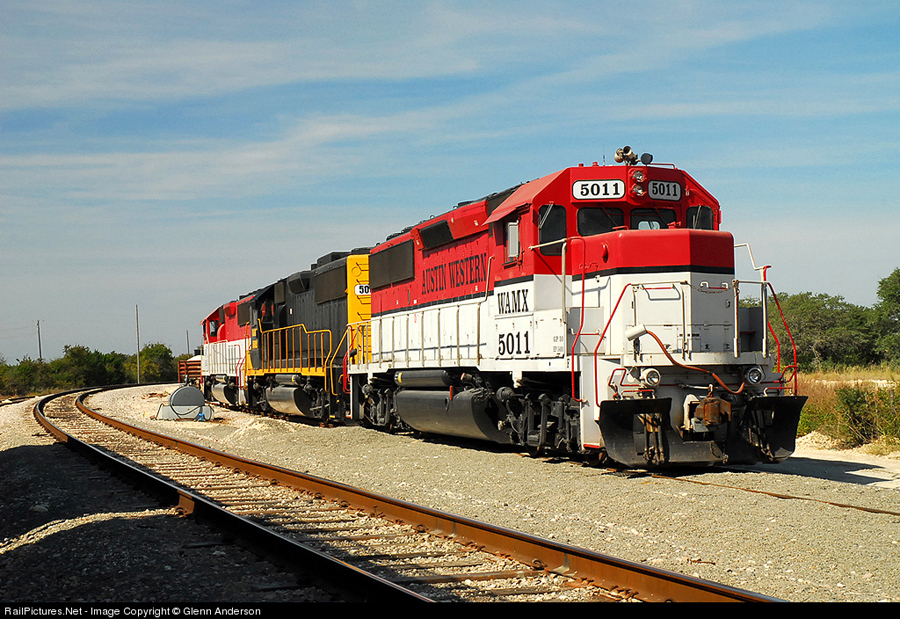 |
| I took some "people pictures" in the lounge around Hutto. Here, Messrs. Arbuckle (left) and Copeland "enjoy" the drab Texas scenery. |
| Here are, from left, Messrs. Phil Moser, Nigel Eacock of Great Britain (a friend of Richard Maund's, whom we see on many of these trips but had already done this detour, as many others had), and Brian Cutter, an Amtrak agent in St. Paul, Minn.. |
| At Taylor, while we held to the ex-MP main to add a pilot, UP 9817 North waited its turn to either follow us, or go straight ahead on the old MKT. Our scheduled time at Taylor was 10:22; we were there from 10:10 to 10:27, but I'm not sure if we handled passengers there or not. Physically, we easily could have, but officially, the detour missed the Taylor stop. The loading area is right at the junction and is not large, but could've been reached easily by coach passengers without crossing a rail. |
| North of Taylor, I handed my camera to, I think, Nigel, for a shot to prove I was there. It was Rich Copeland's choice to ride "backwards"-- he was at the table in that seat when I walked in at Austin to join the group. |
| This "group photo" was taken by Art Bliss of Phoenix (ex-Boston, and still a Mass Bay RRE guy), From left, we are Bob Hannaford, Nigel Eacock, Mike Kirk (from Waupaca in upstate Wisconsin, who doesn't collect mileage but was returning home with his wife from a Texas visit somewhere), then at the next table, Chuck Weinstock and Phil Moser, then Brian Cutter, then across the aisle, Arbuckle, Copeland, and Ingles. |
| And here is Art Bliss, at the table behind mine and Copeland's. |
| On the detour, we passed depots at Rockdale (10:56), Hearne (11:54), and Kilgore (3:30 pm), but I didn't attempt any depot photos from the train. Hearne's has been relocated a bit to the north from its foundation, still visible at the diamond with our MP line and UP's Ennis Sub, the former SP (Houston & Texas Central) Dallas-Houston route, which many of us covered behind SP 4-8-4 4449 when it did a Dallas side trip en route to the World's Fair in New Orleans in 1984. The other two depots are in-place. We'd passed Milano, crossing of BNSF's Galveston Sub (the old Santa Fe to Houston, which Amtrak's Lone Star / Texas Chief used, at 11:10, and Valley Jct., crossing of UP's Navasota Sub (ex-MP Houston-Dallas route) at 11:28. This photo looks south on the Navasota Sub; the junction has connections in all 4 quadrants. To this point, we'd only seen one train on our line, a northbound we overtook at Majorie at 10:51. |
| Four miles beyond Valley Jct., we stopped in the south end of Hearne to change pilots, staying there from 11:37 to 11:52. As we sat, a stack train went south to our right, bound for Flatonia and the Sunset Route. |
| Our speed ranged from 35 mph in spots to 60, and we cruised through Palestine without stopping at 2 p.m., after we'd had lunch in the diner, probably representing the majority of their business this morning. Palestine ended the new mileage for some of us (not me), as a UP steam trip with 3985 in the 1990s (IIRC) had gone thru here on its last leg to Houston, of a trip that began at Little Rock, Ark., went down to Alexandria, La., then over to Shreveport and then Longview, Texas, before heading south again. I snapped these two shots of UP power in the yard at Palestine, then the sign that seems to be where the depot had been. |
| Having not been in this area before Amtrak, I was glad to see photos sent around on the Internet by a friend in California, which the late Murrell Hogue, a long-time passenger-train advocate and Amtrak agent -- in his last career years at Texarkana -- had taken in the 1960s of MoPac trains at Palestine. Here they are for you to enjoy. |
 |
 |
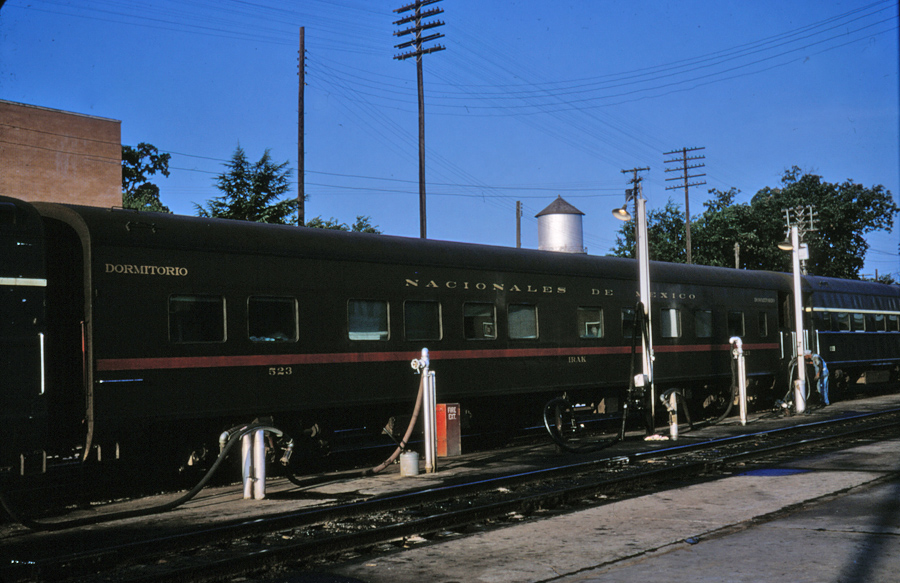 |
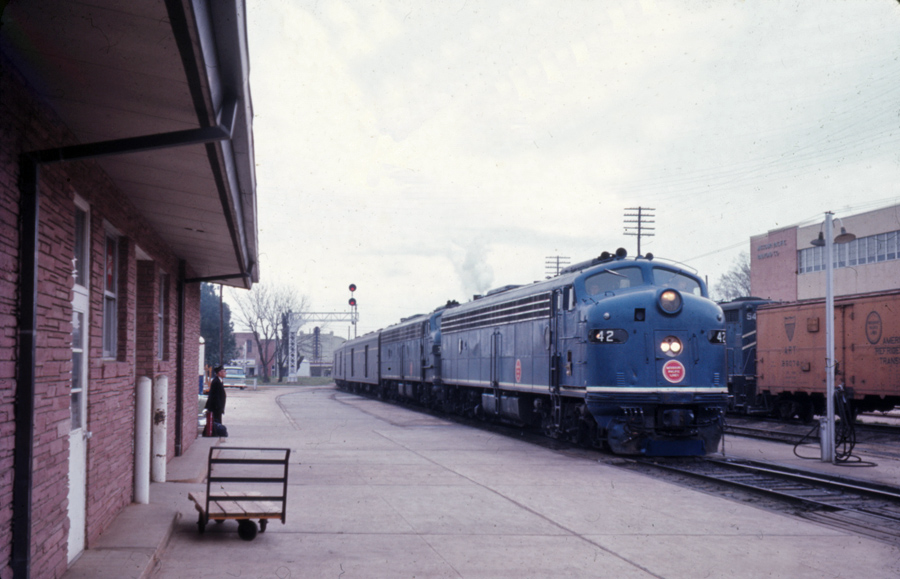 |
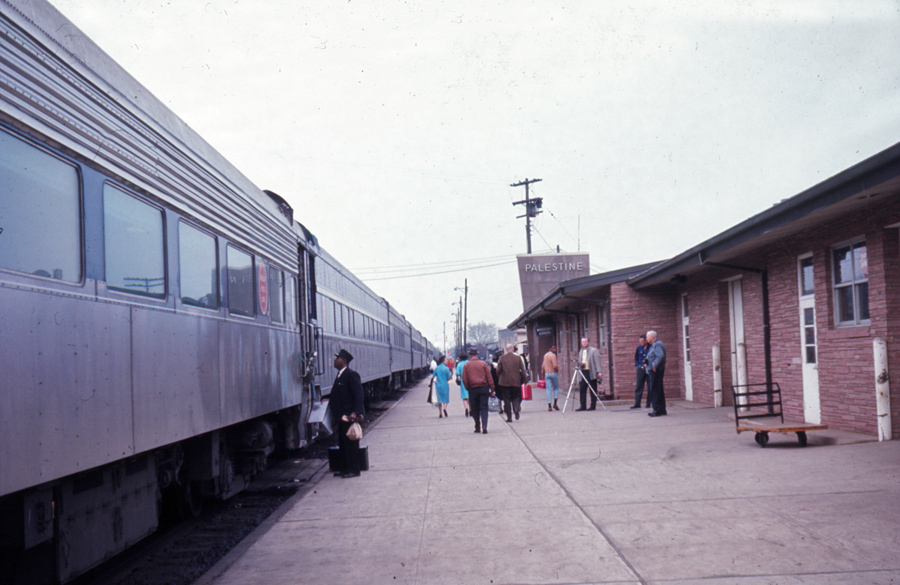 |
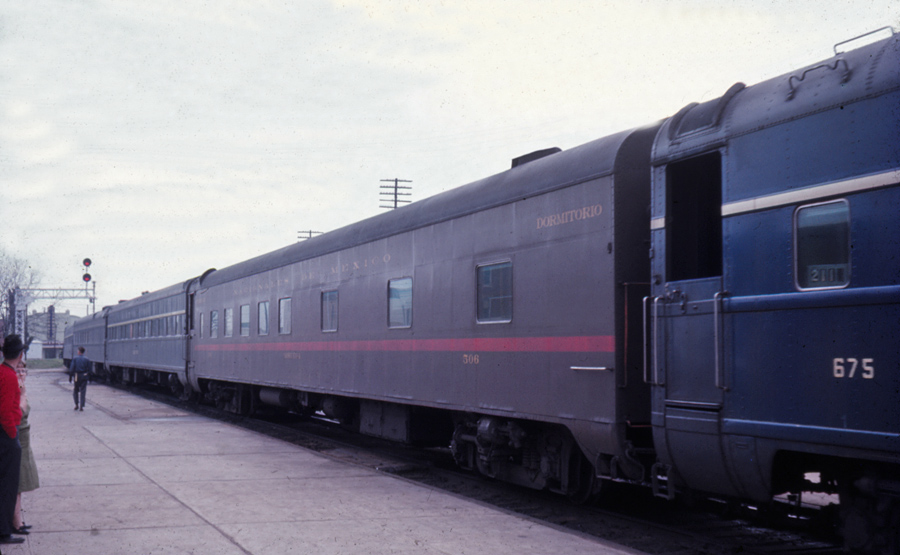 |
| North of Palestine, there wasn't much to shoot, although I was alert thru Jacksonville -- a town with the same name as the Illinois town where I went to college -- despite having confirmed that its depot was gone, back in 2005 when a carload of us drove from Longview after a PV-charter short-line trip that ended there, down to Palestine to ride the Texas State Railroad. To show the importance of "Friday night lights," i.e., high school football in Texas, here is the "Tomato Bowl," the stadium that's home of the Jacksonville Fight'n Indians, to quote the sign. We passed this town, 54 miles out of Longview, at 2:37 p.m. |
| Our adventure on new mileage was winding down, so I passed some time with a few more "people shots" in the lounge. Passing the time in the next 3 shots are Phil Moser and John Arbuckle; Chuck Weinstock and Phil; and Brian Cutter. |
| We alternated between stretches of 49 mph and 60 mph, passing Kilgore, home of the famous Kllgore College Rangerettes dance team, established in 1939. We passed a northbound tri-level "vehicle train" at Kilgore at 3:30. At 3:48, we stopped at Cotton Street in Longview, the last grade crossing before hitting the east-west main line at the station, in order to let some mainline freights pass. We happened to stop with the lounge car on a street viaduct over Green St., and look at the little street that paralleled our track for a few blocks. |
| At 4:18, we pulled on into the depot, stopping at 4:20 to unload passengers destined for there. The brief station stop allowed all of us to disembark to stretch our legs, and we took advantage of it for front-end shots and also a group photo, taken by our sleeper attendant Ernesto Rodriguez. (Left to right, in case you haven't been paying attention: Rich, Phil, me, John, and Chuck.) That finished my photography for the day. Soon we were alerted to reboard, and the train backed up to clear the switch for the Palestine line, and sat there for perhaps an hour. Messrs. Arbuckle and Copeland left us to visit in the depot until the buses showed up from Dallas, Fort Worth, etc., then taxied to a motel for the night; they would take #21 back to Fort Worth the next day, John continuing on back to Norman, Okla., and his car, and Rich to ride some DART light-rail routes before flying home to Philadelphia. We took advantage of the lull to eventually go have dinner, and eventually we left Longview at 6:17, 2 minutes late. We believe of all the Palestine detours our mileage-collector friends rode, ours set the "record" for an early arrival into Longview of just about 2 hours ahead of normal schedule. My only three timekeeping notes of later in the evening had us at Marshall from 6:47 to 7:31, an on-time departure (it's a crew-change point with padding), Texarkana (9:02-9:08, out 25 minutes late — so much for schedule-padding!), and at Hope, Ark., at 9:40 for a momentary halt, still down 25 minutes. |
| We arrived 44 minutes early into St. Louis next morning, at 6:35, so I took advantage of the stop to get up, washed, and dressed, and stepped out only briefly. Chuck and Brian had left as soon as we pulled in to board the light-rail and get to the airport, where they each got on an earlier Southwest flight, in a change of itinerary, to Chicago Midway, where they parted and flew home to Pittsburgh and Minneapolis, respectively. This left only Phil and me, from our group, on board (We didn't see Nigel until he stopped by our rooms to say good-bye just before Springfield, where he got off to take the Thruway Bus to Galesburg to catch the Southwest Chief.). Since my roomette was on the east side, I could not take photos of St. Louis' skyline in the bright morning light, and my first shot was of Lenox Tower in Mitchell, Ill., one of the last, if not the last (excepting moveable bridges) staffed towers in the St. Louis area. Now a UP-manned tower, in the classic days it guarded the crossings of GM&O, New York Central, Wabash, and Alton & Southern (at A&S's north end), and also handled trains of Burlington Route and C&EI. Now it's Amtrak, UP, KCS, and NS. This view looks east; that's NS's two-track main behind it. We were basically on time at our next stop of Alton (8:43) and Carlinville (9:05). |
| Here is a cramped view of the old GM&O station in Springfield, where during my years there (1967-71) I boarded and got off of many a train, ate in the tiny Greer's Restaurant in its south end, and took many a photo. We left 2 minutes late at 9:57. |
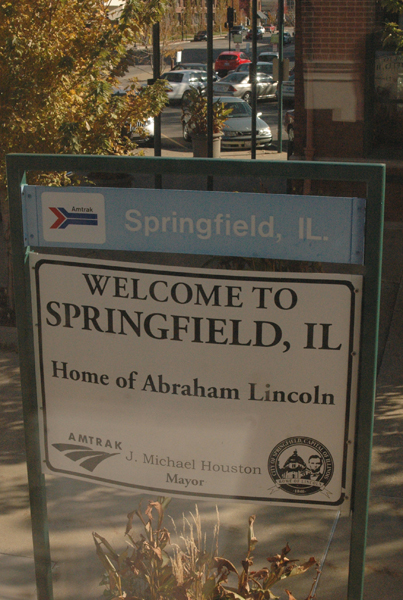 |
| In the north end of Springfield, we took the siding at Ridgely and moved slowly to allow Amtrak Lincoln Service train 301 to pass us, at 10:06, and arrived at Lincoln, our next stop, 5 minutes late, leaving 8 minutes down at 10:33. This is a remarkably good piece of timing for #22, which often is late in this area for various reasons. Amtrak uses a brick shelter just south of the old GM&O depot (which, back in the day, also served interurban Illinois Terminal, whose track was in the parallel street to the east), which has been a restaurant but I believe presently is closed. (Some ex-IC passenger cars and cabooses are part of the establishment on the north end.) Still, of all the years I've seen this old depot, I never had noticed the stained glass window up top with a train! We were on-time out of Normal, Ill., our next stop (new station on the opposite side from me) at 11:08. |
 |
| The only reason I include this photo is that I'm proud of my reflexes on the D70's shutter, as this is train 303 -- at speed (!) -- passing us at Ballard. Now I will admit he was not at full speed, having slowed down for, according to the scanner, an exchange "of a package" with our head end, an instruction that was rescinded as #303 neared the north switch at Ballard, a siding 16 miles north of normal, between Lexington and Chenoa. | 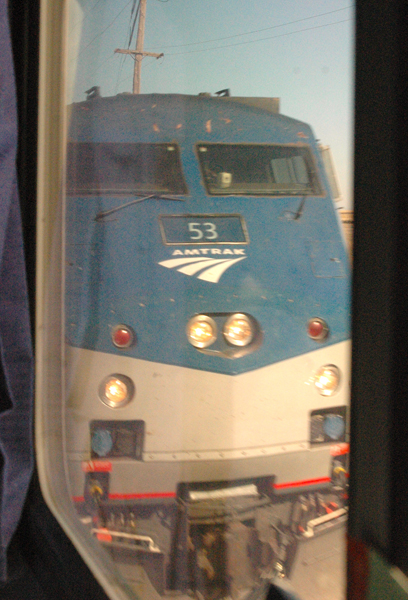 |
| This photo depicts something I'd never noticed before, until going south on #21 four days previous, both times with a room on the east side. It's a surviving concrete arch deck structure over a creek that rises just south of Ocoya and flows north into the Vermilion River northwest of Pontiac (Illinois has two Vermilion Rivers, one over at Danville, flowing into the Wabash). Old Route 66 is next to the railroad on the west side, but lower than the rails, so one couldn't see this unless he's on a train (and perhaps up high like I was), and with trees not in full foliage. It's at Milepost 97 just north of Ocoya. One Internet list of Illinois interurbans lists the Bloomington, Pontiac & Joliet Electric Railway, which ran 1906–1925 but is listed as completed only between Pontiac and Dwight, north of this location, so this bridge may never have had track on it? |
| Pulling out of Joliet 5 minutes early at 12:51 (permissiable as it's dicharge-only), I made sure, with my vantage point, to take a photo of what is now Joliet's Fire Dept. headquarters. Notice the native stone construction and bay-window facing west -- this was, for a brief time, the passenger station of the Elgin, Joliet & Eastern, and each time I see it, it seems to have been modified more, on the north end. Perhaps it will stay as-is here. |
| As we passed through the busy Brighton Park crossing (formerly "Panhandle," now just "Brighton" according to the signal acknowledgement on the radio), I snapped this northbound CSX train waiting for us to pass. No CTA Orange Line "L" train showed up on the viaduct, alas. |
| Going past the Amtrak yard, I took advantage of my upper level room and good sun angle to make a few snapshots. I have inquired about the special lettering on P42 189, which I assume was on an expanded Heartland Flyer or special train to Texas for the Oklahoma-Texas football game on Oct. 12, won be the Longhorns 36-20. They play at the Cotton Bowl in Dallas every year. The NPCU (cab control unit) 90368, which we see on Hiawatha trains a lot, is still in the old stripe scheme, so perhaps we could consider it a "heritage unit"? I shot P32 517, serving as a yard engine, just because good shots of these can be hard to come by. We arrived at Union Station at 1:43 p.m., 9 minutes early, and I easily made my 3:15 p.m. Hiawatha #337 for Milwaukee. |
| Northbound out of Chicago, I kept watching the full shadows of our train -- I was in the second Horizon coach -- but never lifted the camera as I should have. Up north of Sturtevant, I settled for this "extremely long shadow" view of our head end, spread out across the cleared fields just before the sun went down. |
| Carol met me at Milwaukee's airport station, basically on-time at 4:28 p.m. after a routine run north entirely on Track 1, and I couldn't resist this sunset shot on the freeway en route home, to finish out an Amtrak weekend to Texas and back. |
This page was designed and is maintained by Mike Condren. If you have materials
that you would like to contribute, contact me at mcondren@cbu.edu